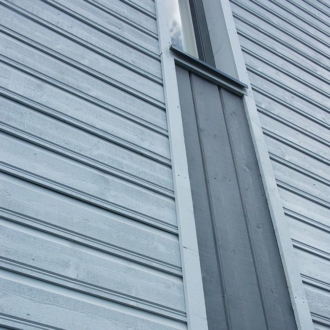Applications for planed goods
A very typical form of further processing of sawn timber is planing, often combined with some kind of surface treatment.
At this point sawn timber sizes are also split to smaller sizes as well. A planing mill can be an integrated operation with sawmilling, or a separate and often – in order to maximize efficiencies – a specialised mill.
Typical planed goods are:
- interior panelling
- various types of exterior cladding
- lamellas for glued products
- small mouldings
- different components
Profiled boards
Profiled boards include a wide variety of boards, usually linked to exterior or interior cladding. There are various different cladding patterns in different countries, even within countries.
These boards are nowadays exceedingly available with paint, wax or pressure treatment. Especially the interior goods are normally shrink wrapped into smaller bundles for easier handling and protection.

Exterior cladding
Usually, the outside facing side of exterior cladding is either fine sawn or planed, the reverse side having stress grooves etc. but in general it is less critical from the surface point of view.
The use and profiles of exterior cladding is very country specific, but the primed and painted options are gaining market share everywhere.
In Finland, where exterior timber cladding is very common, most products are of the type UTS, UTV or UTW.
Interior panelling
Normally, the outside facing side is planed smooth and the rear is rough. The rear has longitudinal grooves, with a depth of about one quarter of the thickness of the piece. Interior panelling is also available with edge grooves, allowing a smoother continuous panelling surface.
In Finland, the most used panelling types are STS, STV and STP.
Flooring boards
The upper face of the flooring is normally planed smooth and the rear is rough. Flooring boards are planed in such a way that the board’s inside face (the side close to the heart of the tree) is up for uniform look, shape and better durability.
Flooring boards have normally edge grooves and they are kiln dried to a lower moisture content in order to minimize movement and shrinkage.
Other profiled products
Wood-based goods are used a lot for interior decoration for end uses like skirting boards (the board on the edge of the flooring) and various boards on the walls and for the ceilings.
There is a huge variation in the profiles of this type, depending on the country and even the manufacturer. These types of boards are increasingly available with surface coating, either painted or lacquered.


